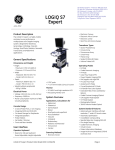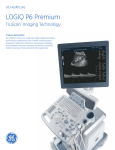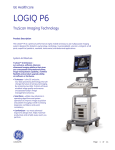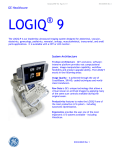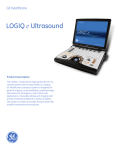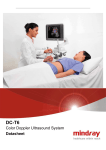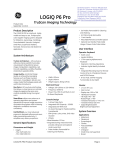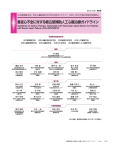Download GE LOGIQ S8 Product Datasheet
Transcript
GE Healthcare LOGIQ S8 Product Datasheet Product description The LOGIQ* S8 is our premium multi-purpose ultrasound imaging system designed for abdominal, vascular, breast, cardiac, small parts, obstetrics, gynecology, neonatal, pediatrics, urology and transcranial applications. General specifications Dimensions and weight Height Width Depth Weight Maximum: 1750 mm (68.9 in) Minimum: 1150 mm (45.3 in) Keyboard: 500 mm (19.7 in) Caster: 620 mm (24.4 in) Maximum: 880 mm (34.6 in) Caster: 790 mm (31.1 in) 85 kg (187.4 lbs) Electrical power Voltage Frequency Power consumption 100 – 120 Vac or 220 – 240 Vac 50/60 Hz Maximum of 900 VA with peripherals Console design 4 Active probe ports and 1 parking Integrated HDD Integrated DVD multi-drive On-board storage of thermal printer Integrated speakers Locking mechanism that provides rolling lock and caster swivel lock Integrated cable management Front and rear handles Easily removable air filters User interface Operator keyboard Operating keyboard adjustable in two dimensions: •Height •Rotation Backlit alphanumeric keyboard Ergonomic hard key layout Interactive back-lighting Integrated recording keys for remote control of up to 6 peripheral or DICOM** devices Integrated gel warmer Touch screen Wide 9” high-resolution, color, touch, LCD screen Interactive dynamic software menu Brightness adjustment User-configurable layout LCD Monitor 19” high-resolution LCD LCD translation (independent of console): •660 mm horizontal (end to end) •135 mm vertical (end to end) •90° swivel Fold-down and lock mechanism for transportation Brightness and contrast adjustment Resolution: 1280 x 1024 Horizontal/Vertical viewing angle of ±170° System overview Applications Abdominal Obstetrical Gynecological Breast Small parts Vascular/peripheral Transcranial Pediatrics and neonatal Musculoskeletal Urological Cardiac Operating Modes B-Mode M-Mode Color Flow Mode (CFM) TVI (Option) B-Flow*/B-Flow Color (Option) Extended Field of View (LOGIQView, Option) Power Doppler Imaging (PDI) PW Doppler CW Doppler (Option) Volume Modes (3D/4D) •Static 3D •Real-Time 4D (Option) Anatomical M-Mode Curved Anatomical M-Mode B Steer+ (Option) Coded Contrast Imaging (Option) Elastography (Option) Scanning methods Electronic Sector Electronic Convex Electronic Linear Mechanic Volume Sweep Transducer types Sector Phased Array Convex Array Micro convex Array Linear Array Matrix Array Volume Probes (4D) •Convex Array •Micro convex Array Split Crystal System standard features Advanced user interface with high resolution wide 9” LCD touch panel Automatic Optimization CrossXBeam* Speckle Reduction Imaging (SRI-HD) Fine Angle Steer Coded Harmonic Imaging Virtual Convex Patient information database Image Archive on integrated CD/DVD and hard drive 3D Raw Data Analysis Real-Time automatic Doppler Calcs OB Calcs Fetal Trending Multi-gestational Calcs Hip Dysplasia Calcs Gynecological Calcs Vascular Calcs Urological Calcs Renal Calcs Cardiac Calcs InSite*ExC capability On-board electronic documentation Peripheral Options Integrated options for: •Digital BW thermal printer •DVD video recorder •Digital color thermal printer Digital A6 color thermal printer External USB printer connection DVI-D output available for compatible devices Foot Switch with programmable functionality Display modes Live and Stored Display Format: Full size and split screen – both with thumbnails. For still and Cine. Review Image Format: 4 x 4 and “thumbnails.” For still and Cine. Simultaneous Capability •B or CrossXBeam/PW •B or CrossXBeam/CFM or PDI •B/M •B/CrossXBeam •Real-Time Triplex Mode (B or CrossXBeam + CFM or PDI/PW or CW (Option)) Selectable alternating Modes •B or CrossXBeam/PW •B or CrossXBeam + CFM (PDI)/PW (CW (Option)) •B/CW (Option) Multi-image (split/quad screen) •Live and/or frozen •B or CrossXBeam + B or CrossXBeam/CFM or PDI •PW/M •Independent Cine playback Timeline display •Independent Dual B or CrossXBeam/PW Display •CW Display Formats •Top/Bottom selectable format •Side/Side selectable format •Timeline only Virtual Convex Display annotation Patient Name: First, Last and Middle Patient ID 2nd Patient ID Age, Sex and Birth Date Hospital Name Date format: 3 types selectable •MM/DD/YY •DD/MM/YY •YY/MM/DD Time format: 2 types selectable •24 hours •12 hours Gestational Age from LMP/EDD/GA/BBT Probe Name Map names Probe Orientation Depth Scale Marker Lateral Scale Marker Focal Zone Markers Image Depth Zoom Depth B-Mode •Gain •Dynamic Range •Imaging Frequency •Frame Averaging •Gray Map •SRI-HD M-Mode •Gain •Dynamic Range •Time Scale Doppler Mode •Gain •Angle •Sample Volume Depth and Width •Wall Filter •Velocity and/or Frequency Scale •Spectrum Inversion •Time Scale •PRF •Doppler Frequency Color Flow Mode •Line Density •Frame Averaging •Packet Size •Color Scale: 3 types – Power, Directional PDI, and Symmetrical Velocity Imaging •Color Velocity Range and Baseline •Color Threshold Marker •Color Gain •PDI •Inversion •Doppler Frequency TGC Curve Acoustic Frame Rate Cine Gage, Image Number/Frame Number Body Pattern: Multiple human and animal types Application Name Measurement Results Operator Message Displayed Acoustic Output •TIS: Thermal Index Soft Tissue •TIC: Thermal Index Cranial (Bone) •TIB: Thermal Index Bone •MI: Mechanical Index % of Maximum Power output Biopsy Guide Line and Zone Heart Rate General System parameters System setup Pre-programmable Categories User Programmable Preset Capability Factory Default Preset Data Languages: English, French, German, Spanish, Italian, Portuguese, Russian, Greek, Swedish, Danish, Dutch, Finnish, Norwegian, Japanese (message only), Chinese (message only) OB Report Formats including Tokyo Univ., Osaka Univ., USA, Europe, and ASUM User Defined Annotations Body Patterns Customized Comment Home Position User Manual available on board through Help (F1) User Manual and Service Manual are included on CD with each system. A printed manual is available upon request. Cine memory/Image memory 384 MB of Cine Memory Selectable Cine Sequence for Cine Review Prospective Cine Mark Measurements/Calculations and Annotations on Cine Playback Scrolling timeline memory Dual Image Cine Display Quad Image Cine Display Cine Gauge and Cine Image Number Display Cine Review Loop Cine Review Speed Image storage On-board database of patient information from past exams Storage Formats: •DICOM – compressed/uncompressed, single/multi-frame, with/without Raw Data •Export JPEG, JPEG2000, WMV (MPEG 4) and AVI formats Storage Devices: •USB Memory Stick: 64 MB to 4 GB (for exporting individual images/clips) •CD-RW storage: 700 MB •DVD storage: -R (4.7 GB) •Hard Drive Image Storage: ~112 GB Compare previous exam images with current exam images Reload of archived data sets Network Storage support for Import, Export, DICOM Read, SaveAs, SaveAs Image, Report SaveAs, MPEGVue Connectivity and DICOM Ethernet network connection Wireless LAN (Option) DICOM 3.0 (Option) •Verify •Print •Store •Modality Worklist •Storage Commitment •Modality Performed Procedure Step (MPPS) •Media Exchange •Off network/mobile storage queue •Query/Retrieve Public SR Template •Structured Reporting – compatible with vascular and OB standard InSite ExC capability Physiological Input Panel (Option) Physiological Input •ECG, 2 lead •Dual R-Trigger •Pre-settable ECG R Delay Time •Pre-settable ECG Position •Adjustable ECG Gain Control Automatic Heart Rate Display Report Writer (Option) On-board reporting package automates report writing Formats various exam results into a report suitable for printing or reviewing on a standard PC Exam result reports can include patient info, exam info, measurements, calculations, images, comments and physician diagnosis Standard templates provided Customizable templates Scanning parameters Displayed Imaging Depth: 0 – 33 cm Minimum Depth of Field: 0 – 2 cm (Zoom) (probe dependent) Maximum Depth of Field: 0 – 33 cm (probe dependent) Continuous Dynamic Receive Focus/Continuous Dynamic Receive Aperture Adjustable Dynamic Range Adjustable Field of View (FOV) Image Reverse: Right/Left Image Rotation of 0°, 180° Digital B-Mode Adjustable: •Acoustic Power •Gain •Dynamic Range •Frame Averaging •Gray Scale Map •Frequency •Speed of Sound (probe, application dependent) •Line Density •Scanning Size (FOV or Angle – depending on the probe, see probe specifications) •B Colorization •Reject •Suppression •SRI-HD •Edge Enhance Digital M-Mode Adjustable: •Acoustic Power •Gain •Dynamic Range •Gray Scale Map •Frequency •Sweep Speed •M Colorization •M Display Format •Rejection Anatomical M-Mode M-mode cursor adjustable at any plane Can be activated from a Cine loop from a live or stored image M and A capability Available with Color Flow Mode Curved Anatomical M-Mode Digital Spectral Doppler Mode Adjustable: •Acoustic Power •Gain •Dynamic Range •Gray Scale Map •Transmit Frequency •Wall Filter •PW Colorization •Velocity Scale Range •Sweep Speed •Sample Volume Length •Angle Correction •Steered Linear •Spectrum Inversion •Trace Method •Baseline Shift •Doppler Auto Trace •Time Resolution •Compression •Trace Direction •Trace Sensitivity Digital Color Flow Mode Adjustable: •Acoustic Power •Color Maps, including velocity-variance maps •Gain •Velocity Scale Range •Wall Filter •Packet Size •Line Density •Spatial Filter •Steering Angle •Baseline Shift •Frame Average •Threshold •Accumulation mode •Sample Volume Control •Flash Suppression Digital Power Doppler Imaging Adjustable: •Acoustic Power •Color Maps, including velocity-variance maps •Gain •Velocity Scale Range •Wall Filter •Packet Size •Line Density •Spatial Filter •Steering Angle •Frame Average •Threshold •Accumulation mode •Sample Volume Control •Flash Suppression Continuous Wave Doppler (Option) Available on M5S-D, 3Sp-D, S4-10-D, 6Tc-RS, P2D, P6D Steerable CW mode includes Adjustable: •Acoustic Power •Gain •Dynamic Range •Gray Scale Map •Transmit Frequency •Wall Filter •CW Colorization •Velocity Scale Range •Sweep Speed •Angle Correction •Spectrum Inversion •Trace Method •Baseline Shift •Doppler Auto Trace •Compression •Trace Direction •Trace Sensitivity Gray Scale Map Tint Map Dynamic Range Rejection Gain Dual Beam B-Flow Color Accumulation B Steer+ (Option) Available on 9L-D, 11L-D, ML6-15-D, L8-18i-D Coded Contrast Imaging (Option) Available on 3CRF-D, C1-5D, C2-6b-D, IC5-9-D, 9L-D, 11L-D, ML6-15-D, M5S-D, L8-18i-D, RAB6-D 2 Contrast Timers Timed Updates: 0.05 – 10 seconds Accumulation mode, six levels Maximum Enhance Mode Flash Time Intensity Curve (TIC) Analysis Auto MI control The LOGIQ S8 is designed for compatibility with commercially available ultrasound contrast agents. Because the availability of these agents is subject to government regulation and approval, product features intended for use with these agents may not be commercially marketed nor made available before the contrast agent is cleared for use. Contrast related product features are enabled only on systems for delivery to an authorized country or region of use. LOGIQView (Option) Available on all 2D and 4D probes B-Flow (Option) 3D Automatic Optimization Optimize B-Mode image to help improve contrast resolution Selectable amount of contrast resolution enhancement (low, medium, high) Auto-Spectral Optimize – adjusts baseline, invert, PRF (on live image), and angle correction Coded Harmonic Imaging Available on C1-5-D, 9L-D, 11L-D, ML6-15-D, M5S-D, S1-5-D, L8-18i-D, 10C-D Background: On/Off Sensitivity/PRI Line Density Edge Enhance Frame Average Extended Field of View Imaging Available on the following probes: 9L-D, 11L-D, ML6-15-D, L8-18i-D, 3CRF-D, C1-5D, C2-6b-D, 10C-D, IC5-9-D, S1-5-D, M5S-D, 3Sp-D, S4-10-D, RAB6-D, RIC5-9-D, 6Tc-RS For use in B-Mode CrossXBeam is available on linear probes Auto detection of scan direction Pre- or post-process zoom Rotation Auto fit on monitor Measurements in B-Mode Allows unlimited rotation and planar translations 3D reconstruction from Cine sweep Advanced 3D Thyroid Productivity Package (Option) Acquisition of Color data Automatic rendering 3D Landscape technology 3D Movie Worksheet summary includes measurements and locations for nodule, parathyroid and lymph node Feature Assessment User editable Real-Time 4D (Option) Elastography (Option) Acquisition Modes: •Real-Time 4D •Static 3D Visualization Modes: •3D Rendering (diverse surface and intensity projection modes) •Sectional Planes (3 Section planes perpendicular to each other) •Volume Contrast Imaging-Static (Option) •Tomographic Ultrasound Imaging (Option) Render Mode: •Surface Texture, Surface Smooth, max-, min- and X-ray (average intensity projection), mix mode of two render modes Curved 3 point Render start 3D Movie Scalpel: 3D Cut tool Display Format: •Quad: A-/B-/C-Plane/3D •Dual: A-Plane/3D •Single: 3D or A- or B- or C-Plane Automated Volume Calculation – VOCAL II (Option) BetaView Auto Sweep Available on ML6-15-D, 11L-D, 9L-D, C1-5-D, IC5-9-D Scan Assistant (Option) Factory Programs User-defined programs Steps include image annotations, mode transitions, basic imaging controls and measurement initiation Compare Assistant (Option) Allows side-by-side comparison of previous ultrasound and other modality exams during live scanning Power Assistant (Option) Allows moving the system without a complete system shutdown and boot-up power cycle Breast Productivity Package (Option) Allows automatic contour and measurement of breast lesions Worksheet summary Feature Assessment BI-RADS Assessment User editable Elastography Quantification (Option – not available in the United States) Relative quantification tool Available on ML6-15-D, 11L-D, 9L-D, IC5-9-D, C1-5-D Quantitative Flow Analysis (Option) Available in Color and Power Doppler TVI (Option) Myocardial Doppler Imaging with color overlay on tissue image Available on the sector probes Tissue color overlay can be removed to show just the 2D image, still retaining the tissue velocity information Curved Anatomical M-mode: free (curved) drawing of M-mode generated from the cursor independent from the axial plane Q-Analysis: Multiple Time-Motion trace display from selected points in the myocardium Stress Echo (Option) Advanced and flexible stress-echo examination capabilities Provides exercise and pharmacological protocol templates 8 default templates Template editor for user configuration of existing templates or creation of new templates Reference scan display during acquisition for stress level comparison (dual screen) Baseline level/Previous level selectable Raw data continuous capture Over 100 sec available Wall motion scoring (bulls-eye and segmental) Smart stress: Automatically set up various scanning parameters (for instance, geometry, frequency, gain, etc.) according to same projection on previous level Virtual Convex Provides a convex field of view Compatible with CrossXBeam Available on all linear and sector transducers: 9L-D, 11L-D, ML6-15-D, L8-18i-D, S1-5-D, M5S-D, 3Sp-D, S4-10-D, 6Tc-RS SRI-HD Speckle Reduction Imaging Provides multiple levels of speckle reduction Compatible with Side by Side DualView Display Compatible with ALL linear, convex and sector transducers Compatible with B-Mode, Color, Contrast Agent and 3D imaging CrossXBeam Provides 3, 5, 7, or 9 angles of spatial compounding Live Side by Side DualView Display Compatible with: •Color Mode •PW •SRI-HD •Coded Harmonic Imaging •Virtual Convex Available on 9L-D, 11L-D, ML6-15-D, L8-18i-D, 3CRF-D, C1-5D, C2-6b-D, 10C-D, IC5-9-D, RAB6-D, RIC5-9-D Controls Available While “Live” Write Zoom B/M/CrossXBeam-Mode •Gain •TGC •Dynamic Range •Acoustic Output •Transmission Focus Position •Transmission Focus Number •Line Density Control •Sweep Speed for M-Mode •Number of Angles for CrossXBeam PW-Mode •Gain •Dynamic Range •Acoustic Output •Transmission Frequency •PRF •Wall Filter •Spectral Averaging •Sample Volume Gate – Length – Depth •Velocity Scale •Time Resolution Color Flow Mode •CFM Gain •CFM Velocity Range •Acoustic Output •Wall Echo Filter •Packet Size •Frame Rate Control •CFM Spatial Filter •CFM Frame Averaging •CFM Line Resolution •Frequency/Velocity Baseline Shift Controls Available on “Freeze” or Recall Automatic Optimization SRI-HD CrossXBeam – Display non-compounded and compounded image simultaneously in split screen 3D reconstruction from a stored Cine loop B/M/CrossXBeam Mode •Gray Map Optimization •TGC •Colorized B and M •Frame Average (loops only) •Dynamic Range Anatomical M Mode •Max. Read Zoom to 8x •Baseline Shift •Sweep Speed PW Mode •Gray Map •Post Gain •Baseline shift •Sweep Speed •Invert Spectral wave form •Compression •Rejection •Colorized Spectrum •Display Format •Doppler Audio •Angle Correct •Quick Angle Correct •Auto Angle Correct Color Flow •Overall Gain (loops and stills) •Color Map •Transparency Map •Frame Averaging (loops only) •Flash Suppression •CFM Display Threshold •Spectral Invert for Color/Doppler Anatomical M-Mode on Cine loop 4D •Gray Map, Colorize •Post Gain •Change display – single, dual, quad sectional or rendered Measurements/Calculations Generic B-Mode Depth and Distance Circumference (Ellipse/Trace) Area (Ellipse/Trace) Volume (Ellipsoid) % Stenosis (Area or Diameter) Angle between two lines General M-Mode M-Depth Distance Time Slope Heart Rate Generic Doppler Measurements/Calculations Velocity Time A/B Ratio (Velocities/Frequency Ratio) PS (Peak Systole) ED (End Diastole) PS/ED (PS/ED Ratio) ED/PS (ED/PS Ratio) AT (Acceleration Time) ACCEL (Acceleration) TAMAX (Time Averaged Maximum Velocity) Volume Flow (TAMEAN and Vessel Area) Heart Rate PI (Pulsatility Index) RI (Resistivity Index) Real-Time Doppler Auto Measurements/Calculations PS (Peak Systole) ED (End Diastole) MD (Minimum Diastole) PI (Pulsatility Index) RI (Resistivity Index) AT (Acceleration Time) ACC (Acceleration) PS/ED (PS/ED Ratio) ED/PS (ED/PS Ratio) HR (Heart Rate) TAMAX (Time Averaged Maximum Velocity) PVAL (Peak Velocity Value) Volume Flow (TAMEAN and Vessel Area) OB Measurements/Calculations Gestational Age by: •GS (Gestational Sac) •CRL (Crown Rump Length) •FL (Femur Length) •BPD (Biparietal Diameter) •AC (Abdominal Circumference) •HC (Head Circumference) •APTD x TTD (Anterior/Posterior Trunk Diameter by Transverse Trunk Diameter) •FTA (Fetal Trunk Cross-sectional Area) •HL (Humerus Length) •BD (Binocular Distance) •FT (Foot Length) •OFD (Occipital Frontal Diameter) •TAD (Transverse Abdominal Diameter) •TCD (Transverse Cerebellum Diameter) •THD (Thorax Transverse Diameter) •TIB (Tibia Length) •ULNA (Ulna Length) Estimated Fetal Weight (EFW) by: •AC, BPD •AC, BPD, FL •AC, BPD, FL, HC •AC, FL •AC, FL, HC •AC, HC •BPD, APTD, TTD, FL •BPD, APTD, TTD, SL Calculations and Ratios •FL/BPD •FL/AC •FL/HC •HC/AC •CI (Cephalic Index) •AFI (Amniotic Fluid Index) •CTAR (Cardio-Thoracic Area Ratio) Measurements/Calculations by: ASUM, ASUM 2001, Berkowitz, Bertagnoli, Brenner, Campbell, CFEF, Chitty, Eik-Nes, Ericksen, Goldstein, Hadlock, Hansmann, Hellman, Hill, Hohler, Jeanty, JSUM, Kurtz, Mayden, Mercer, Merz, Moore, Nelson, Osaka University, Paris, Rempen, Robinson, Shepard, Shepard/Warsoff, Tokyo University, Tokyo/Shinozuka, Yarkoni Fetal Graphical Trending Growth Percentiles Multi-Gestational Calculations (4) Fetal Qualitative Description (Anatomical survey) Fetal Environmental Description (Biophysical profile) Programmable OB Tables Over 20 selectable OB Calcs Expanded Worksheets OB Measure Assistant (Option) Allows automatic contour and measurement of BPD, HC, FL and AC User editable Breast Measure Assistant (Option) Allows automatic contour and measurement of breast lesions User editable GYN Measurements/Calculations Right Ovary Length, Width, Height Left Ovary Length, Width, Height Uterus Length, Width, Height Cervix Length, Trace Ovarian Volume ENDO (Endometrial thickness) Ovarian RI Uterine RI Follicular measurements Summary Reports Vascular Measurements/Calculations SYS DCCA (Systolic Distal Common Carotid Artery) DIAS DCCA (Diastolic Distal Common Carotid Artery) SYS MCCA (Systolic Mid Common Carotid Artery) DIAS MCCA (Diastolic Mid Common Carotid Artery) SYS PCCA (Systolic Proximal Common Carotid Artery) DIAS PCCA (Diastolic Proximal Common Carotid Artery) SYS DICA (Systolic Distal Internal Carotid Artery) DIAS DICA (Systolic Distal Internal Carotid Artery) SYS MICA (Systolic Mid Internal Carotid Artery) DIAS MICA (Diastolic Mid Internal Carotid Artery) SYS PICA (Systolic Proximal Internal Carotid Artery) DIAS PICA (Diastolic Proximal Internal Carotid Artery) SYS DECA (Systolic Distal External Carotid Artery) DIAS DECA (Diastolic Distal External Carotid Artery) SYS PECA (Systolic Proximal External Carotid Artery) DIAS PECA (Diastolic Proximal External Carotid Artery) VERT (Systolic Vertebral Velocity) SUBCLAV (Systolic Subclavian Velocity) Automatic IMT (Option) Summary Reports Auto EF (Option) Allows semi-automatic measurement of the global EF (Ejection Fraction) User editable Urological Calculations Bladder Volume Prostate Volume Lt/Rt Renal Volume Generic Volume Post-Void Bladder Volume Probes (All Optional) 3CRF-D Micro Convex Biopsy Probe Applications Biopsy Guide Abdomen Single-Angle, disposable with a reusable bracket (40442LR), Multi-Angle with a reusable bracket (H40452LP) C1-5-D Convex Probe Applications Biopsy Guide Abdomen, OB, Gynecology, Urology, Vascular Multi-Angle, disposable with a reusable bracket (H40432LE) C2-6b-D Biopsy Convex Probe Applications Biopsy Guide Abdomen Multi-Angle, disposable with a disposable bracket 10C-D Micro convex Probe Applications Neonatal, Pediatrics, Vascular IC5-9-D Micro convex Probe Applications Biopsy Guide OB, Gynecology, Urological Single-Angle, Disposable with a disposable bracket (E8385MJ) or reusable bracket (H40412LN) S1-5-D Sector Probe Applications Biopsy Guide Abdomen, OB, Gynecology, Vascular Multi-Angle, disposable with a reusable bracket (H4908SD) S4-10-D Sector Probe Applications Pediatrics, Neonatal M5S-D Sector Probe Applications Cardiac, Transcranial 3Sp-D Sector Probe Applications Cardiac, Transcranial 9L-D Linear Probe Applications Biopsy Guide Vascular, Small Parts, Pediatrics, Abdomen Multi-Angle, disposable with a reusable bracket (H4906BK) 11L-D Linear Probe Applications Biopsy Guide Available Vascular, Small Parts, Pediatrics, Neonatal Multi- Angle, disposable with a reusable bracket (H40432LC) ML6-15-D Matrix Array Linear Probe Applications Biopsy Guide Available Small Parts, Vascular, Neonatal, Pediatrics Multi-Angle, disposable with a reusable bracket (H40432LK) L8-18i-D Linear Probe Applications Small Parts, Vascular, Intraoperative RAB6-D Convex Volume Probe Applications Biopsy Guide Abdomen, OB, Gynecology, Pediatrics Single-Angle, disposable with a reusable bracket (H48681ML) RIC5-9-D Convex Volume Probe Applications Biopsy Guide OB, Gynecology, Urology Single-Angle, Reusable (H46721 R) 6Tc-RS Trans-esophageal Probe Applications TEE RS-DLP Adapter (H46352LK) required Cardiac P2D CW Split Crystal Probe Applications Cardiac, Vascular P6D CW Split Crystal Probe Applications Cardiac, Vascular External Inputs and Outputs (not including on-board peripherals) DVI-D signal with HDMI connector Ethernet Multiple USB 2.0 ports Safety Conformance The LOGIQ S8 is: Classified to UL 60601-1 by a Nationally Recognized Test Lab Certified to CAN/CSA-C22.2 No. 601.1-M90 by an SCC accredited Test Lab CE Marked to Council Directive 93/42/EEC on Medical Devices Conforms to the following standards for safety: •EN 60601-1 Medical electrical equipment – Part 1: General requirements for safety •EN 60601-1-1 Medical electrical equipment – Part 1-1 General requirements for safety – Collateral Standard: Safety requirements for medical electrical systems •EN 60601-1-2 Medical electrical equipment – Part 1-2 General requirements for safety – Collateral Standard: Electromagnetic compatibility – requirements and tests •EN 60601-1-4 Medical electrical equipment Part 1-4 General requirements for safety – Collateral Standard: programmable electrical medical systems •EN 60601-1-6 Medical electrical equipment Part 1-6 General requirements for basic safety and essential performance – Collateral Standard: Usability •EN 60601-2-37 Medical electrical equipment – Part 2-37: Particular requirements for the safety of ultrasonic medical diagnostic and monitoring equipment •ISO 10993-1 Biological evaluation of medical devices – Part 1 Evaluation and testing •NEMA UD2 Acoustic output measurement standard for diagnostic ultrasound equipment •NEMA UD3 Standard for Real-Time display of thermal and mechanical acoustic output indices on diagnostic ultrasound equipment (MI, TIS, TIB, TIC) •EMC Emissions Group 1 Class B device requirements as per Subclause 4.2 of CISPR 11 SUPPLEMENT Cardiac Measurements/Calculations B-Mode Measurements Aorta •Aortic Root Diameter (Ao Root Diam) •Aortic Arch Diameter (Ao Arch Diam) •Ascending Aortic Diameter (Ao Asc) •Descending Aortic Diameter (Ao Desc Diam) •Aorta Isthmus (Ao Isthmus) •Aorta (Ao st junct) Aortic Valve •Aortic Valve Cusp Separation (AV Cusp) •Aortic Valve Area Planimetry (AVA Planimetry) •(Trans AVA) Left Atrium •Left Atrium Diameter (LA Diam) •LA Length (LA Major) •LA Width (LA Minor) •Left Atrium Diameter to AoRoot Diameter Ratio (LA/Ao Ratio) •Left Atrium Area (LAA(d), LAA(s)) •Left Atrium Volume, Single Plane, Method of Disk (LAEDV A2C, LAESV A2C) (LAEDV A4C, LAESV A4C) Left Ventricle •Left Ventricle Mass (LVPWd, LVPWs) •Left Ventricle Volume, Teichholz/Cubic (LVIDd, LVI Ds) •Left Ventricle Internal Diameter (LVIDd, LVI Ds) •Left Ventricle Length (LVLd, LVLs) •Left Ventricle Outflow Tract Diameter (LVOT Diam) •Left Ventricle Posterior Wall Thickness (LVPWd, LVPWs) •Left Ventricle Length (LV Major) •Left Ventricle Width (LV Minor) •Left Ventricle Outflow Tract Area (LVOT) •Left Ventricle Area, Two Chamber/Four Chamber/Short Axis (LVA (d), LVA (s)) •Left Ventricle Endocardial Area, Width (LVA (d), LVA(s)) •Left Ventricle Epicardial Area, Length (LVAepi (d), LVAepi(s)) •Left Ventricle Mass Index (LVPWd, LVPWs) •Ejection Fraction, Teichholz/Cube (LVIDd, LVIDs) •Left Ventricle Posterior Wall Fractional Shortening (LVPWd, LVPWs) •Left Ventricle Stroke Index, Teichholz/Cube (LVIDd, LVIDs and Body Surface Area) •Left Ventricle Fractional Shortening (LVIDd, LVIDs) •Left Ventricle Stroke Volume, Teichholz/Cubic (LVIDd, LVIDs) •Left Ventricle Stroke Index, Single Plane, Two Chamber, Method of Disk (LVI Dd, LVIDs, LVSd, LVSs) •Left Ventricle Stroke Index, Single Plane, Four Chamber, Method of Disk (LVI Dd, LVIDs, LVSd, LVSs) •Left Ventricle Stroke Index, Bi-Plane, Bullet, Method of Disk (LVAd, LVAs) •Interventricular Septum (IVS) •Left Ventricle Internal Diameter (LVI D) •Left Ventricle Posterior Wall Thickness (LVPW) Mitral Valve •Mitral Valve Annulus Diameter (MV Ann Diam) •E-Point-to-Septum Separation (EPSS) •Mitral Valve Area Planimetry (MVA Planimetry) Pulmonic Valve •Pulmonic Valve Area (PV Planimetry) •Pulmonic Valve Annulus Diameter (PV Annulus Diam) •Pulmonic Diameter (Pulmonic Diam) Right Atrium •Right Atrium Diameter, Length (RAD Ma) •Right Atrium Diameter, Width (RAD Mi) •Right Atrium Area (RAA) •Right Atrium Volume, Single Plane, Method of Disk (RAAd) •Right Atrium Volume, Systolic, Single Plane, Method of Disk (RAAs) Right Ventricle •Right Ventricle Outflow Tract Area (RVOT Planimetry) •Left Pulmonary Artery Area (LPA Area) •Right Pulmonary Artery Area (RPA Area) •Right Ventricle Internal Diameter (RVIDd, RVIDs) •Right Ventricle Diameter, Length (RVD Ma) •Right Ventricle Diameter, Width (RVD Mi) •Right Ventricle Wall Thickness (RVAWd, RVAWs) •Right Ventricle Outflow Tract Diameter (RVOT Diam) •Left Pulmonary Artery (LPA) •Main Pulmonary Artery (MPA) •Right Pulmonary Artery (RPA) System •Inferior Vena Cava •Systemic Vein Diameter (Systemic Diam) •Patent Ductus Arterosis Diameter (PDA Diam) •Pericard Effusion (PEs) •Patent Foramen Ovale Diameter (PFO Diam) •Ventricular Septal Defect Diameter (VSD Diam) •Interventricular Septum (IVS) Fractional Shortening (IVSd, IVSs) Tricuspid Valve •Tricuspid Valve Area (TV Panimetry) •Tricuspid Valve Annulus Diameter (TV Annulus Diam) M-Mode Measurements Aorta •Aortic Root Diameter (Ao Root Diam) Aortic Valve •Aortic Valve Diameter (AV Diam) •Aortic Valve Cusp Separation (AV Cusp) •Aortic Valve Ejection Time (LVET) Left Atrium •Left Atrium Diameter to AoRoot Diameter Ratio (LA/Ao Ratio) •Left Atrium Diameter (LA Diam) Left Ventricle •Left Ventricle Volume, Teichholz/Cubic (LVIDd, LVI Ds) •Left Ventricle Internal Diameter (LVIDd, LVI Ds) •Left Ventricle Posterior Wall Thickness (LVPWd, LVPWs) •Left Ventricle Ejection Time (LVET) •Left Ventricle Pre-Ejection Period (LVPEP) •Interventricular Septum (IVS) •Left Ventricle Internal Diameter (LVI D) •Left Ventricle Posterior Wall Thickness (LVPW) Mitral Valve •E-Point-to-Septum Separation (EPSS) •Mitral Valve Leaflet Separation (D-E Excursion) •Mitral Valve Anterior Leaflet Excursion (D-E Excursion) •Mitral Valve D-E Slope (D-E Slope) •Mitral Valve E-F Slope (E-F Slope) Pulmonic Valve •QRS complex to end of envelope (Q-to-PV close) Right Ventricle •Right Ventricle Internal Diameter (RVIDd, RVIDs) •Right Ventricle Wall Thickness (RVAWd, RVAWs) •Right Ventricle Outflow Tract Diameter (RVOT Diam) •Right Ventricle Ejection Time (RVET) •Right Ventricle Pre-Ejection Period (RVPEP) System •Pericard Effusion (PE (d)) Tricuspid Valve •QRS complex to end of envelope (Q-to-TV close) Doppler Mode Measurements Aortic Valve •Aortic Insufficiency Mean Pressure Gradient (AR Trace) •Aortic Insufficiency Peak Pressure Gradient (AR Vmax) •Aortic Insufficiency End Diastole Pressure Gradient (AR Trace) •Aortic Insufficiency Mean Velocity (AR Trace) •Aortic Insufficiency Velocity Time Integral (AR Trace) •Aortic Valve Mean Velocity (AV Trace) •Aortic Valve Velocity Time Integral (AV Trace) •Aortic Valve Mean Pressure Gradient (AV Trace) •Aortic Valve Peak Pressure Gradient (AR Vmax) •Aortic Insufficiency Peak Velocity (AR Vmax) •Aortic Insufficiency End-Diastolic Velocity (AR Trace) •Aortic Valve Peak Velocity (AV Vmax) •Aortic Valve Peak Velocity at Point E (AV Vmax) •Aorta Proximal Coarctation (Coarc Pre-Duct) •Aorta Distal Coarctation (Coarc Post-Duct) •Aortic Valve Insufficiency Pressure Half Time (AR PHT) •Aortic Valve Flow Acceleration (AV Trace) •Aortic Valve Pressure Half Time (AV Trace) •Aortic Valve Acceleration Time (AV Acc Ti me) •Aortic Valve Deceleration TIme (AV Trace) •Aortic Valve Ejection Time (AVET) •Aortic Valve Acceleration to Ejection Time Ratio (AV Acc Time, AVET) •Aortic Valve Area according to PHT Left Ventricle •Left Ventricle Outflow Tract Peak Pressure Gradient (VLOT Vmax) •Left Ventricle Outflow Tract Peak Velocity (LVOT Vmax) •Left Ventricle Outflow Tract Mean Pressure Gradient (LVOT Trace) •Left Ventricle Outflow Tract Mean Velocity (LVOT Trace) •Left Ventricle Outflow Tract Velocity Time Integral (LVOT Trace) •Left Ventricle Ejection Time (LVET) Mitral Valve •Mitral Valve Regurgitant Flow Acceleration (MR Trace) •Mitral Valve Regurgitant Mean Velocity (MR Trace) •Mitral Regurgitant Mean Pressure Gradient (MR Trace) •Mitral Regurgitant Velocity Time Integral (MR Trace) •Mitral Valve Mean Velocity (MR Trace) •Mitral Valve Velocity Time Integral (MR Trace) •Mitral Valve Mean Pressure Gradient (MR Trace) •Mitral Regurgitant Peak Pressure Gradient (MR Vmax) •Mitral Valve Peak Pressure Gradient (MR Vmax) •Mitral Regurgitant Peak Velocity (MR Vmax) •Mitral Valve Peak Velocity (MR Vmax) •Mitral Valve Velocity Peak A (MV A Velocity) •Mitral Valve Velocity Peak E (MV E Velocity) •Mitral Valve Area according to PHT (MV PHT) •Mitral Valve Flow Deceleration (MV Trace) •Mitral Valve Pressure Half Time (PV PHT) •Mitral Valve Flow Acceleration (MV Trace) •Mitral Valve E-Peak to A-Peak Ratio (A-C and D-E) (MV E/A Ratio) •Mitral Valve Acceleration Time (MV Acc Time) •Mitral Valve Deceleration Time (MV Dec Time) •Mitral Valve Ejection Time ((MV Trace) •Mitral Valve A-Wave Duration (MV A Dur) •Mitral Valve Time to Peak (MV Trace) •Mitral Valve Acceleration Time/Deceleration Time Ratio (MVAcc/Dec Time) •Stroke Volume Index by Mitral Flow (MVA Planimetry, MVTrace) Pulmonic Valve •Pulmonic Insufficiency Peak Pressure Gradient (PR Vmax) •Pulmonic Insufficiency End-Diastolic Pressure Gradient (PR Trace) •Pulmonic Valve Peak Pressure Gradient (PV Vmax) •Pulmonic Insufficiency Peak Velocity (PR Vmax) •Pulmonic Insufficiency End-Diastolic Velocity (Prend Vmax) •Pulmonic Valve Peak Velocity (PV Vmax) •Pulmonary Artery Diastolic Pressure (PV Trace) •Pulmonic Insufficiency Mean Pressure Gradient (PR Trace) •Pulmonic Valve Mean Pressure Gradient (PV Trace) •Pulmonic Insufficiency Mean Square Root Velocity (PR Trace) •Pulmonic Insufficiency Velocity Time Integral (PR Trace) •Pulmonic Valve Mean Velocity (PV Trace) •Pulmonic Valve Velocity Time Integral (PV Trace) •Pulmonic Insufficiency Pressure Half Time (PR PHT) •Pulmonic Valve Flow Acceleration (PV Acc Time) •Pulmonic Valve Acceleration Time (PV Acc Time) •Pulmonic Valve Ejection Time (PVET) •QRS complex to end of envelope (Q-to-PV close) •Pulmonic Valve Acceleration to Ejection TIme Ratio (PV Acc Time, PVET) Right Ventricle •Right Ventricle Outflow Tract Peak Pressure Gradient (RVOT Vmax) •Right Ventricle Outflow Tract Peak Velocity (RVOT Vmax) •Right Ventricle Outflow Tract Velocity Time Integral (RVOT Trace) •Right Ventricle Ejection Time (RV Trace) •Stroke Volume by Pulmonic Flow (RVOT Planimetry, RVOT Trace) •Right Ventricle Stroke Volume Index by Pulmonic Flow (RVOT Planimetry, RVOT Trace) System •Pulmonary Artery Peak Velocity (PV Vmax) •Pulmonary Vein Velocity Peak A (reverse) (P Vein A) •Pulmonary Vein Peak Velocity (P Vein D, P Vein S) •Systemic Vein Peak Velocity (PDA Diastolic, PDA Systolic) •Ventricular Septal Defect Peak Velocity (VSD Vmax) •Atrial Septal Defect (ASD Diastolic, ASD Systolic) •Pulmonary Vein A-Wave Duration (P Vein A Dur) •IsoVolumetric Relaxation Time (IVRT) •IsoVolumetric Contraction Time (IVCT) •Pulmonary Vein S/D Ratio (P Vein D, P Vein S) •Ventricular Septal Defect Peak Pressure Gradient (VSD Vmax) •Pulmonic-to-Systemic Flow Ratio (Qp/Qs) Tricuspid Valve •Tricuspid Regurgitant Peak Pressure Gradient (TR Vmax) •Tricuspid Valve Peak Pressure Gradient (TV Vmax) •Tricuspid Regurgitant Peak Velocity (TR Vmax) •Tricuspid Valve Peak Velocity (TV Vmax) •Tricuspid Valve Velocity Peak A (TV A Velocity) •Tricuspid Valve Velocity Peak E (TV E Velocity) •Tricuspid Regurgitant Mean Pressure Gradient (TR Trace) •Tricuspid Valve Mean Pressure Gradient (TV Trace) •Tricuspid Regurgitant Mean Velocity (TR Trace) •Tricuspid Regurgitant Velocity Time Integral (TR Trace) •Tricuspid Valve Mean Velocity (TV Trace) •Tricuspid Valve Velocity Time Integral (TV Trace) •Tricuspid Valve Time to Peak (TV Acc/Dec Time) •Tricuspid Valve Ejection Time (TV Acc/Dec Time) •Tricuspid Valve A-Wave Duration (TV A Dur) •QRS complex to end of envelope (Q-to-TV close) •Tricuspid Valve Pressure Half Time (TV PHT) •Stroke Volume by Tricuspid Flow (TV Planimetry, TV Trace) •Tricuspid Valve E-Peak to A-Peak Ratio (TV E/A Velocity) Color Flow Mode Measurements Aortic Valve •Proximal Isovelocity Surface Area: Regurgitant Orifice Area (AR Radius) •Proximal Isovelocity Surface Area: Radius of Aliased Point (AR Radius) •Proximal Isovelocity Surface Area: Regurgitant Flow (AR Trace) •Proximal Isovelocity Surface Area: Regurgitant Volume Flow (AR Trace) •Proximal Isovelocity Surface Area: Aliased Velocity (AR Vmax) Mitral Valve •Proximal Isovelocity Surface Area: Regurgitant Orifice Area (MR Radius) •Proximal Isovelocity Surface Area: Radius of Aliased Point (MR Radius) •Proximal Isovelocity Surface Area: Regurgitant Flow (MR Trace) •Proximal Isovelocity Surface Area: Regurgitant Volume Flow (MR Trace) •Proximal Isovelocity Surface Area: Aliased Velocity (MR Vmax) Combination Mode Measurements Aortic Valve •Aortic Valve Area (Ao Root Diam, LVOT Vmax, AV Vmax) •Aortic Valve Area by Continuity Equation by Peak Velocity (Ao Root Diam, LVOT Vmax, AV Vmax) •Stroke Volume by Aortic Flow (AVA Pl ani met ry, AV Trace) •Cardiac Output by Aortic Flow (AVA Planimetry, AV Trace, HR) •Aortic Valve Area by Continuity Equation VTI (Ao Root Diam, LVOT Vmax, AV Trace) Left Ventricle •Cardiac Output, Teichholz/Cubic (LVIDd, LVI Ds, HR) •Cardiac Output Two Chamber, Single Plane, Area-Length/ Method of Disk(Simpson) (LVAd, LVAs, HR) •Cardiac Output Four Chamber, Single Plane, Area-Length/ Method of Disk (Simpson) (LVAd, LVAs, HR) •Ejection Fraction Two Chamber, Single Plane, Area-Length/ Method of Disk (Simpson) (LVAd, LVAs) •Ejection Fraction Four Chamber, Single Plane, Area-Length/ Method of Disk (Simpson) (LVAd, LVAs) •Left Ventricle Stroke Volume, Single Plane, Two Chamber/Four Chamber, Area-Length (LVAd, LVAs) •Left Ventricle Stroke Volume, Single Plane, Two Chamber/Four Chamber, Method of Disk (Simpson) (LVIDd, LVIDs, LVAd, LVAs) •Left Ventricle Volume, Two Chamber/Four Chamber, Area- Length (LVAd, LVAs) •Ejection Fraction, Bi-Plane, Method of Disk (LVAd, LVAs, 2CH, 4CH) •Left Ventricle Stroke Volume, Bi-Plane, Method of Disk (LVAd, LVAs, 2CH, 4CH) •Left Ventricle Volume, Bi-Plane, Method of Disk (LVAd, LVAs, 2CH, 4CH) •Left Ventricle Stroke Index, Single Plane, Two Chamber/Four Chamber, Area-Length (LVSd, LVSs and BSA) •Left Ventricle Volume, Single Plane, Two Chamber/Four Chamber, Method of Disk (LVAd, LVAs) •Left Ventricle Volume, Apical View, Long Axis, Method of Disk (LVAd, LVAs) Mitral Valve •Stroke Volume by Mitral Flow (MVA Planimetry, MV Trace) •Cardiac Output by Mitral Flow (MVA Planimetry, MV Trace, HR) Pulmonic Valve •Stroke Volume by Pulmonic Flow (PV Planimetry, PV Trace) •Cardiac Output by Pulmonic Flow (PV Planimetry, PV Trace, HR) Tricuspid Valve •Cardiac Output by Tricuspid Flow (TV Planimetry, TV Trace, HR) Europe GE Healthcare Beethovenstr. 239 D - 42655 Solingen T 49 212 2802 0 F 49 212 2802 28 © 2013 General Electric Company – All rights reserved. APAC GE Healthcare Asia Pacific 4-7-127, Asahigaoka, Hino-shi, Tokyo 191-8503 Japan T +81 42 585 5111 GE Healthcare, a division of General Electric Company. Cardiac Worksheet Parameter: lists the mode, the measurement folder and the specific measurement Measured Value: Up to six measurement values for each item. Average, maximum, minimum, or last Generic Study in Cardiology Stroke Volume (SV) Cardiac Output (CO) General Electric Company reserves the right to make changes in specifications and features shown herein, or discontinue the product described at any time without notice or obligation. Contact your GE Representative for the most current information. GE and GE monogram are trademarks of General Electric Company. * Trademark of General Electric Company. ** Third party trademarks are the property of their respective owners. GE Healthcare 9900 Innovation Drive Wauwatosa, WI 53226 U.S.A. www.gehealthcare.com DOC1310316
















